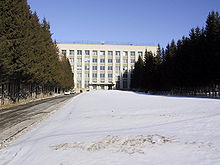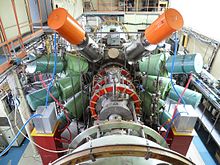 | |
 Budker Institute of Nuclear Physics (BINP) Budker Institute of Nuclear Physics (BINP) | |
| Formation | 1959 |
|---|---|
| Type | Learned society |
| Headquarters | Academician Lavrentyev Avenue, Novosibirsk, Akademgorodok, Novosibirsk Oblast, Russia |
| Location |
|
| Coordinates | 54°50′56″N 83°06′40″E / 54.84875°N 83.11102°E |
Membership | 3,000 |
Official language | Russian |
Director | Pavel V. Logatchov |
| Website | inp |


The Budker Institute of Nuclear Physics (BINP) is one of the major centres of advanced study of nuclear physics in Russia. It is located in the Siberian town Akademgorodok, on Academician Lavrentiev Avenue. The institute was founded by Gersh Budker in 1959. Following his death in 1977, the institute was renamed in honour of Budker.
Despite its name, the centre was not involved either with military atomic science or nuclear reactors— instead, its concentration was on high-energy physics (particularly plasma physics) and particle physics. In 1961 the institute began building VEP-1,[1][2] the first particle accelerator in the Soviet Union which collided two beams of particles, just a few months after the ADA collider became operational at the Frascati National Laboratories in Italy in February 1961.[3] The BINP employs over 3000 people, and hosts research groups and facilities.